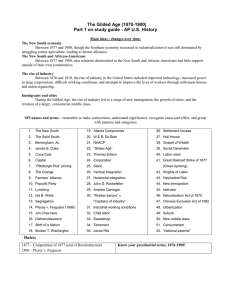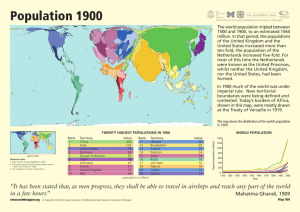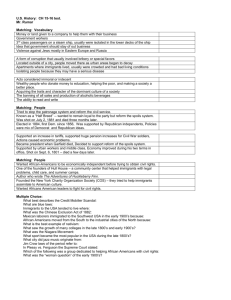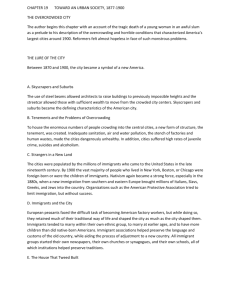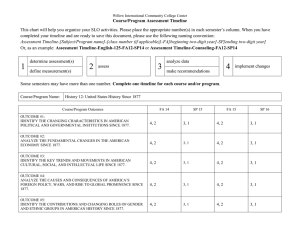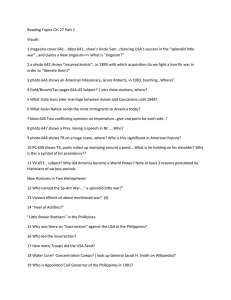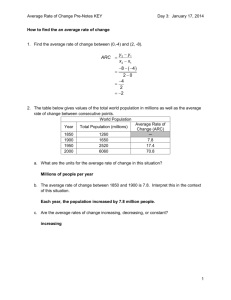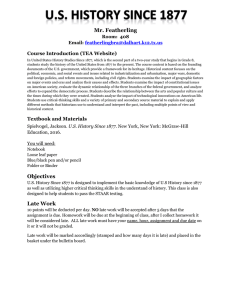Social and Cultural Change, 1877‒1900
advertisement
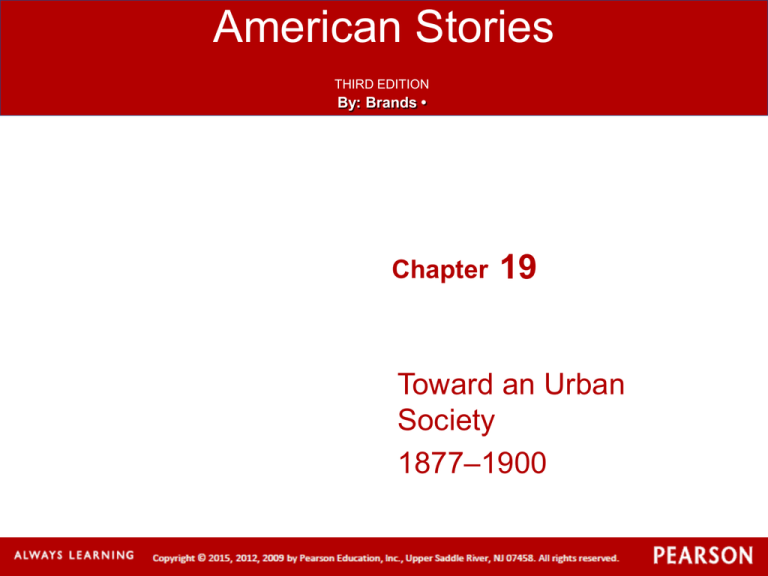
American Stories THIRD EDITION By: Brands • Chapter 19 Toward an Urban Society 1877‒1900 Toward an Urban Society, 1877‒1900 19.1 The Lure of the City Why did cities in the United States grow between 1880 and 1900? 19.2 Social and Cultural Change, 1877‒1900 How did growth of American cities affect social, cultural, and political life? Toward an Urban Society, 1877‒1900 19.3 The Spread of Jim Crow Why did Jim Crow laws spread across the South after the end of Reconstruction? 19.4 The Stirrings of Reform How did life in the growing cities lead to ideas of reform? Video Series: Key Topics in U.S. History 1. 2. 3. 4. An Urban Society The New American City Boss Tweed Plessy v. Ferguson Home The Overcrowded City • Cities grew • People lured by glitter and excitement, friends and relatives already there, and jobs and higher wages • Size increased sevenfold, compared to rural growth, which doubled • Became center of American economic, social, and cultural life Home Home The Lure of the City • Skyscrapers and Suburbs • Tenements and the Problems of Overcrowding • Strangers in a New Land • Immigrants and the City • Urban Political Machines Home The Lure of the City • City - symbol of the new America between 1870–1900 • Similar to the symbol of the factory • Explosive urban growth • Sources included immigration, movement from countryside • Six cities over 500,000 by 1900 • One third of American population by 1900 The Lure of the City Skyscrapers and Suburbs • Skyscrapers • Replaced small buildings – twelve or fewer stories • Design changes • Streetcars • Allowed growth of suburbs • More fragmented and stratified city The Lure of the City The Lure of the City Tenements and the Problems of Overcrowding • Tenements housed working class • James Ware and dumbbell design • City problems • • • • • Overcrowding Inadequate sanitation Poor ventilation Polluted water Crime • Street gangs The Lure of the City What Characterized U.S. Population Patterns in 1900? • What were the population densities of various U.S. regions? • Where had members of major immigrant communities settled by 1900? • In what parts of the United States were African Americans concentrated at this point? The Lure of the City The Lure of the City Strangers in a New Land • Immigrant rates grew • • • • • From Europe New immigrants Demographics Port of entry Increasing percentages • Resurgence of anti-Catholicism and anti-Semitism The Lure of the City The Lure of the City Figure 19.1 Immigration to the United States, 1870–1900 The Lure of the City Immigrants and the City • Immigrant families • Family structure similar to native-born • Growing families • Immigrant associations • Preserved old-country language and customs • Aided the process of adjustment The Lure of the City Urban Political Machines • Urban political party machines • Provided services for cities • Headed by “bosses” • Model: William Tweed, New York City • Role of political bosses • Why bosses stayed in power • Role of bosses can be overemphasized • Many people and institutions involved in governing cities The Lure of the City The Lure of the City Discussion Question • Why did cities in the United States grow between 1880 and 1900? The Lure of the City Social and Cultural Change, 1877‒1900 Manners and Mores Leisure and Entertainment Changes in Family Life Changing Views: A Growing Assertiveness Among Women • Educating the Masses • Higher Education • • • • Home Social and Cultural Change, 1877‒1900 • Industry and cities brought change • • • • • Cultural changes Population growth Rural population still higher than urban Changing eating habits Medical science Social and Cultural Change, 1877‒1900 Manners and Mores • Victorian morality • • • • Dictated dress, manners, sexual behavior Children to be seen and not heard Uniformity in middle-class clothing Strong patriotic and religious values • New moral and political issues • Mugwumps • Women’s Christian Temperance Union (WCTU) Social and Cultural Change, 1877‒1900 Leisure and Entertainment • Domestic leisure • Gathered in the “second parlor” • Games popular • Music – ballads, ragtime, classical • Entertainment outside home • Fairs, horse races, balloon ascensions, bicycle tournaments • Organized spectator sports • Street lights and streetcars Social and Cultural Change, 1877‒1900 Changes in Family Life • Working-class families • Work life changed • On farm, worked together • In city, worked separately for long hours • Lived in complex units • Relatives and boarders taken in to help with rent • Retained strong family ties • Fostered by need to survive in industrial Social and Cultural Change, economy 1877‒1900 Changes in Family Life (continued) • Middle-class families • Women and children grew isolated • Suburban commute took fathers from middle-class homes • Formal schooling lengthened • Domesticity encouraged • White middle-class birth rates declined Social and Cultural Change, 1877‒1900 Changing Views: A Growing Assertiveness Among Women • “New women” • Seen as corruption of ideal vision • Changes in legal codes • Demand for changes • • • • Fight for vote and equal payment Wanted self-fulfillment Supported by psychology and medicine National American Woman Suffrage Association Social and Cultural Change, 1877‒1900 Educating the Masses • Trend toward universal education • Grew from changing role of children • Purpose of education • To train people for life and work in industrializing society • Variations in schooling • Boys and girls - differences • North and South - differences Social and Cultural Change, 1877‒1900 Educating the Masses (continued) • Segregation in education • 1883 - Civil Rights Cases • 1896 - Plessy v. Ferguson • 1899 – Cumming v. County Board of Education Social and Cultural Change, 1877‒1900 Higher Education • Colleges and universities flourished • Greater emphasis on professions and research • More women achieved college education • African Americans usually confined to allblack institutions • Tuskegee Institute in Alabama Social and Cultural Change, 1877‒1900 Higher Education (continued) • Booker T. Washington • Atlanta Compromise • W.E.B. DuBois • Studied sociology • Disagreed with Atlanta Compromise • Demanded quality, integrated education • Trend toward careers in professions • Medicine, dentistry, law Social and Cultural Change, 1877‒1900 Social and Cultural Change, 1877‒1900 Social and Cultural Change, 1877‒1900 Discussion Question • How did the growth of American cities affect social, cultural, and political life? Social and Cultural Change, 1877‒1900 The Spread of Jim Crow • Segregation and disfranchisement grew • Voting, education, housing, jobs • North and federal government did little to stem the tide • Jim Crow laws - all aspects of the South • Violence also spread • Lynching increased • Convict lease system • Racism also in North • Blacks called it James Crow Home Table 19.1 Supreme Court Decisions Affecting Black Civil Rights, 1875–1900 The Spread of Jim Crow The Spread of Jim Crow Discussion Question • Why did Jim Crow laws spread across the South after the end of Reconstruction? The Spread of Jim Crow The Stirrings of Reform • • • • Progress and Poverty New Currents in Social Thought The Settlement Houses A Crisis in Social Welfare Home The Stirrings of Reform • Social Darwinism • • • • Argued against usefulness of reform Applied natural selection to society Influential followers Came under increasing attack The Stirrings of Reform Progress and Poverty • Henry George’s Progress and Poverty • Saw modern society as flawed • Proposed solution: Tax the land, as it is source of wealth • Analysis had more impact than solution • Raised questions for next generation The Stirrings of Reform New Currents in Social Thought • Clarence Darrow • Rejected Social Darwinism • Edward Bellamy’s Looking Backward • Socialist utopia • Social Gospel • Challenged traditional doctrines that poor to blame for own poverty • Focused on improving living conditions as well as saving souls The Stirrings of Reform The Stirrings of Reform The Settlement Houses • Settlement houses • Social workers provided community services in slum areas • Famous houses • Characteristics • Many workers women • Classical and practical education for the poor • Social services • Limits - resentment • Black settlement houses The Stirrings of Reform The Stirrings of Reform A Crisis in Social Welfare • Depression of 1893 revealed insufficiency of private charity • New professionalism in social work • New efforts to understand poverty’s sources • Increasing calls for government intervention The Stirrings of Reform Discussion Question • How did life in the growing cities lead to ideas of reform? The Stirrings of Reform Conclusion: The Pluralistic Society • Immigration and urban growth reshaped American politics and culture • By 1920, most Americans lived in cities • Culturally pluralistic society emerging • Society experienced a crisis between 1870 and 1900 • Reformers turned to state and federal government for remedies to social ills

